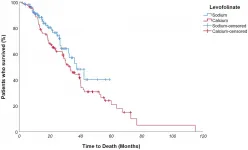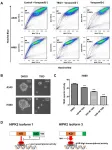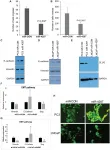Epigenetic mechanism contributing to lifelong stress susceptibility discovered
2021-03-15
(Press-News.org) An epigenetic modification that occurs in a major cell type in the brain's reward circuitry controls how stress early in life increases susceptibility to additional stress in adulthood, researchers at the Icahn School of Medicine at Mount Sinai have learned. In a study in Nature Neuroscience, the team also reported that a small-molecule inhibitor of the enzyme responsible for this modification, currently being developed as an anti-cancer drug, was able to reverse increased vulnerability to lifelong stress in animal models.
"It has long been known that stress exposures throughout life control lifelong susceptibility to subsequent stress. Here we discovered a key molecular mechanism that mediates the lasting effects of that stress," says lead author Hope Kronman, an MD, PhD student in the Nash Family Department of Neuroscience and The Friedman Brain Institute, Icahn School of Medicine at Mount Sinai. "In so doing, we generated an actionable biological target for treating early-life stress-induced susceptibility, which could open the door to potential clinical investigations of this pharmacological target for controlling stress-associated depressive disorders."
A lifelong history of stress is the strongest known risk factor for depression in humans. Previous studies have shown that early-life stress increases the risk of adult depression as much as threefold, depending on its timing, intensity, and specific features. Early-life stress is also known to increase the likelihood of behavioral susceptibility to stress later in life, and to have particularly strong effects on the nucleus accumbens, an essential component of the brain's reward system.
The Mount Sinai study focused on epigenetic modifications within cells; these are chemical changes in the activity of genes that are not triggered by our inherited DNA code, but by molecules that regulate when, where, and to what degree our genetic material is activated. Researchers identified a previously unknown epigenetic mechanism that mediates the lasting effects of early-life stress--a mechanism known as H3K79me2 (demethylation of Lysine 79 of Histone H3) --in the nucleus accumbens. Early-life stress induces this mechanism selectively in D2-type medium spiny neurons of the nucleus accumbens and thereby reprograms the cells to increase vulnerability to a second episode of stress in adulthood.
The discovery of this mechanism involved unbiased approaches of inquiring which epigenetic modification--out of many hundreds--is most likely to mediate the effects of early-life stress in the nucleus accumbens. The researchers used a technique called proteomics to reveal that H3K79me2 is the epigenetic modification most highly regulated by early-life stress in this brain region and, in parallel, used RNA sequencing to show that the most highly regulated epigenetic enzyme is DOT1L, which catalyzes H3K79me2.
The importance of using an unbiased or open-ended approach to identify crucial mechanisms of disease pathophysiology was emphasized by the study's senior author, Eric J. Nestler, MD, PhD, Director of The Friedman Brain Institute and Nash Family Professor of Neuroscience at the Icahn School of Medicine at Mount Sinai. "Through this approach we were able to uncover the essential role played by this one type of histone modification out of many hundreds in mediating the ability of stress early in life to increase susceptibility to stress and potentially depression over a lifetime."
Dr. Nestler and his team further showed that manipulation of the enzyme DOT1L in D2 medium spiny neurons of the nucleus accumbens bidirectionally controls stress susceptibility. That is, increasing DOT1L in this cell type increases stress vulnerability in animal models, while decreasing DOT1L has the opposite effect. "Through the use of RNA sequencing we then demonstrated that DOT1L overexpression dramatically recapitulates the gene expression changes that occur from early life stress, whereas DOT1L knockdown dramatically blocks the ability of early life stress to produce gene expression changes," explains Dr. Nestler.
This investigation set the stage for researchers to test the effect of a selective, small-molecule inhibitor of DOT1L, pinometostat, now in advanced clinical trials for treating acute myeloid leukemia. In the first exploration of the drug's effect on neuropsychiatric disease models, the Mount Sinai team found that twice-daily injections of the inhibitor reversed the susceptibility-priming effects of early life stress on adult animals, without producing detectable side effects.
"We're greatly encouraged by these findings which support the possible use of the novel early life stress mechanism we identified for therapeutic purposes," says Dr. Kronman. "They reveal a fundamentally new pathway for the development of improved treatments for depression, which are urgently needed given that more than one-third of all individuals with this syndrome are inadequately treated with current therapeutics."
INFORMATION:
Other partners in the study included the Perelman School of Medicine at the University of Pennsylvania, and the Department of Neurology at Massachusetts General Hospital. The study was supported by grants from the National Institute of Mental Health and the Hope for Depression Research Foundation.
About the Mount Sinai Health System
The Mount Sinai Health System is New York City's largest academic medical system, encompassing eight hospitals, a leading medical school, and a vast network of ambulatory practices throughout the greater New York region. Mount Sinai is a national and international source of unrivaled education, translational research and discovery, and collaborative clinical leadership ensuring that we deliver the highest quality care--from prevention to treatment of the most serious and complex human diseases. The Health System includes more than 7,200 physicians and features a robust and continually expanding network of multispecialty services, including more than 400 ambulatory practice locations throughout the five boroughs of New York City, Westchester, and Long Island. The Mount Sinai Hospital is ranked No. 14 on U.S. News & World Report's "Honor Roll" of the Top 20 Best Hospitals in the country and the Icahn School of Medicine as one of the Top 20 Best Medical Schools in country. Mount Sinai Health System hospitals are consistently ranked regionally by specialty and our physicians in the top 1% of all physicians nationally by U.S. News & World Report.
For more information, visit https://www.mountsinai.org or find Mount Sinai on Facebook, Twitter and YouTube.
[Attachments] See images for this press release:

ELSE PRESS RELEASES FROM THIS DATE:
2021-03-15
Researchers have found that out of the more than 300 COVID-19 machine learning models described in scientific papers in 2020, none of them is suitable for detecting or diagnosing COVID-19 from standard medical imaging, due to biases, methodological flaws, lack of reproducibility, and 'Frankenstein datasets.'
The team of researchers, led by the University of Cambridge, carried out a systematic review of scientific manuscripts - published between 1 January and 3 October 2020 - describing machine learning models that claimed to be able to diagnose or prognosticate ...
2021-03-15
In considering materials that could become the fabrics of the future, scientists have largely dismissed one widely available option: polyethylene.
The stuff of plastic wrap and grocery bags, polyethylene is thin and lightweight, and could keep you cooler than most textiles because it lets heat through rather than trapping it in. But polyethylene would also lock in water and sweat, as it's unable to draw away and evaporate moisture. This antiwicking property has been a major deterrent to polyethylene's adoption as a wearable textile.
Now, MIT engineers have spun polyethylene into fibers ...
2021-03-15
The loss of glaciers worldwide enhances the breakdown of complex carbon molecules in rivers, potentially contributing further to climate change.
An international research team led by the University of Leeds has for the first time linked glacier-fed mountain rivers with higher rates of plant material decomposition, a major process in the global carbon cycle.
As mountain glaciers melt, water is channelled into rivers downstream. But with global warming accelerating the loss of glaciers, rivers have warmer water temperatures and are less prone to variable water flow and sediment movement. These conditions are then much more favourable for fungi to establish and ...
2021-03-15
Ageing is a common factor in many diseases. So, what if it were possible to treat them by acting on the causes of ageing or, more specifically, by acting on the shortening of telomeres, the structures that protect chromosomes? This strategy is being pursued by the Telomeres and Telomerase Group of the Spanish National Cancer Research Centre (CNIO), which has already succeeded to cure pulmonary fibrosis and infarctions in mice by lengthening telomeres. Now they take a first step towards doing the same with renal fibrosis by demonstrating that short telomeres are at the origin of this disease, ...
2021-03-15
Oncotarget published "Folinic acid in colorectal cancer: esquire or fellow knight? Real-world results from a mono institutional, retrospective study" which reported that the stock of therapeutic weapons available in metastatic colorectal cancer has been progressively grown over the years, with improving both survival and patients' clinical outcome: notwithstanding advances in the knowledge of mCRC biology, as well as advances in treatment, fluoropyrimidine antimetabolite drugs have been for 30 years the mainstay of chemotherapy protocols for this malignancy.
5-Fluorouracil seems to act differently depending on administration method: elastomer-mediated continuous infusion better inhibits Thymidylate ...
2021-03-15
Oncotarget published "A novel isoform of Homeodomain-interacting protein kinase-2 promotes YAP/TEAD transcriptional activity in NSCLC cells" which reported that In this study, the authors show that a new HIPK2 isoform increases TEAD reporter activity in NSCLC cells.
They detected and cloned a novel HIPK2 isoform 3 and found that its forced overexpression promotes TEAD reporter activity in NSCLC cells.
Expressing HIPK2 isoform 3_K228A kinase-dead plasmid failed to increase TEAD reporter activity in NSCLC cells.
Next, they showed that two siRNAs targeting HIPK2 decreased HIPK2 isoform 3 and YAP protein levels in NSCLC cells.
In summary, this Oncotarget study indicates that HIPK2 isoform 3, the main HIPK2 isoform ...
2021-03-15
The cover for issue 51 of Oncotarget features Figure 5, "miR-4287 overexpression regulates EMT in prostate cancer cell lines," published in "MicroRNA-4287 is a novel tumor suppressor microRNA controlling epithelial-to mesenchymal transition in prostate cancer" by Bhagirath, et al. which reported that the authors analyzed the role of miR-4287 in PCa using clinical tissues and cell lines.
Receiver operating curve analysis showed that miR-4287 distinguishes prostate cancer from normal with a specificity of 88.24% and with an Area under the curve of 0.66. Further, these authors found that miR-4287 ...
2021-03-15
NEW YORK, NY (March 15, 2021)--A cytokine "hurricane" centered in the lungs drives respiratory symptoms in patients with severe COVID-19, a new study by immunologists at Columbia University Vagelos College of Physicians and Surgeons suggests.
Two cytokines, CCL2 and CCL3, appear critical in luring immune cells, called monocytes, from the bloodstream into the lungs, where the cells launch an overaggressive attempt to clear the virus.
Targeting these specific cytokines with inhibitors may calm the immune reaction and prevent lung tissue damage. Currently, one drug that blocks immune responses to CCL2 is being studied in clinical trials of patients with severe COVID-19.
Survivors of severe COVID-19, the study also found, had a greater abundance of antiviral T cells in their lungs ...
2021-03-15
Philadelphia, March 15, 2021 - Biomarker testing surveys specific disease-associated molecules to predict treatment response and disease progression; however its use has complicated the diagnosis of non-small-cell lung cancer (NSCLC). In a new study in The Journal of Molecular Diagnosis, published by Elsevier, investigators provide for the first time a complete overview of biomarker testing, spanning multiple treatment lines, in a single cohort of patients.
Using exploratory data analysis and process-mining techniques in a real-world setting, investigators identified significant variation in test utilization and treatment. They also found that while ...
2021-03-15
BOSTON - Researchers at Massachusetts General Hospital (MGH) have uncovered new clues that add to the growing understanding of how female mammals, including humans, "silence" one X chromosome. Their new study, published in Molecular Cell, demonstrates how certain proteins alter the "architecture" of the X chromosome, which contributes to its inactivation. Better understanding of X chromosome inactivation could help scientists figure out how to reverse the process, potentially leading to cures for devastating genetic disorders.
Female mammals have two copies of the X chromosome in all of their cells. Each X chromosome contains many genes, but only one of the pair ...
LAST 30 PRESS RELEASES:
[Press-News.org] Epigenetic mechanism contributing to lifelong stress susceptibility discovered







